Nine lines of original old artists are included in the topic # 49 Scenery Records.
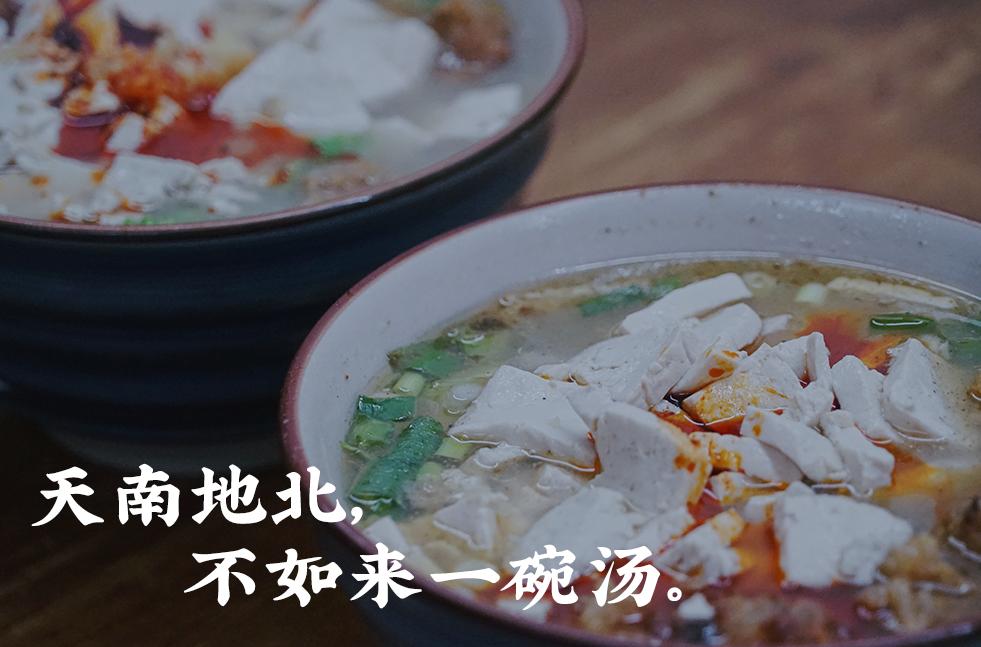
Old artists always thought that only Cantonese people were addicted to soup, but when they met Luoyang people, they didn’t know what a "soup addict" was. We usually say "Have you eaten?" When Luoyang people come up, they just say "Have you drunk?"
This drink means soup.
Luoyang people always take soup seriously. When Cantonese people are still boasting that "three meals a day, no soup", Luoyang people have taken soup as their staple food. Yes, in Guangdong, you can only play "auxiliary" soup, and in Luoyang, you are the absolute C and king.
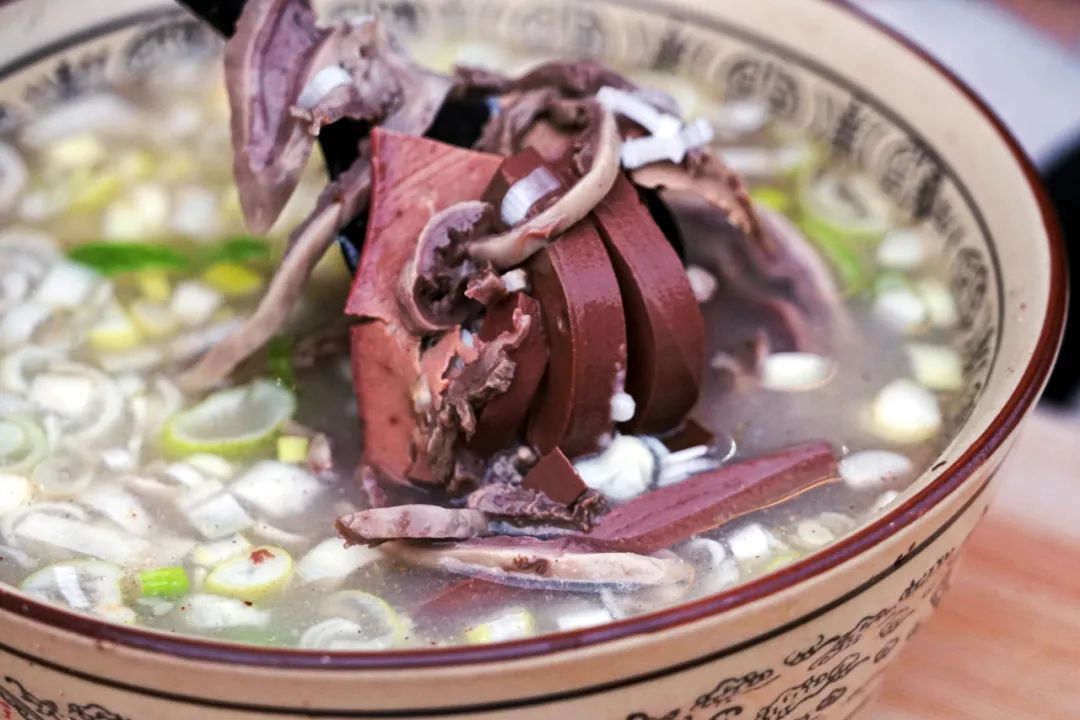
△ Luoyang’s soup/worm
How much do they like soup?
Let’s just say that the Luoyang Water Mat, which has been circulating in the local area for more than 1000 years, has 24 dishes, all of which are soup. It can be said that the word "soup" has been branded in Luoyang people’s genes from the root.
On the streets of Luoyang, whether it is morning, noon or evening, it is standard for the old Luoyang people to have a bowl of soup. A large piece of beef, oil and spicy seeds floating on the bowl, a mouthful, I feel that the whole body is soaked in the dense soup. Unlike Guangdong soup, which is soft and light, Luoyang soup pays attention to rough and heroic. How can it be a "cool" word?
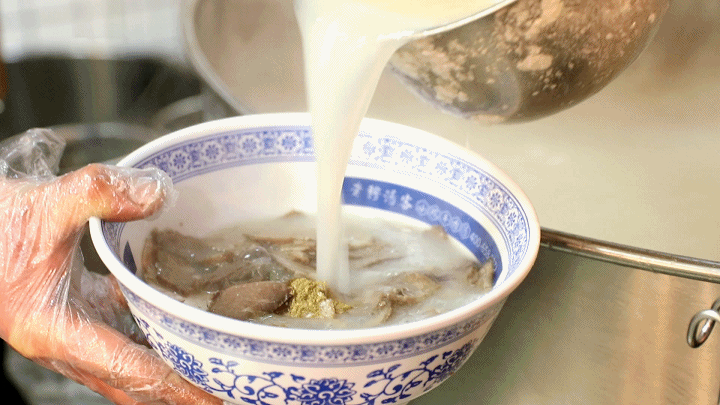
△ The dense Luoyang soup gas
Moreover, in the eyes of outsiders, it seems that there is only Hu spicy soup in Henan. This statement will never be established in Luoyang. Regardless of the "Luoyang water mat", only the combination of meat and vegetables can reach twenty or thirty kinds of soup in Luoyang, and it is not the same for a week.
If you go to Luoyang and only know how to call a bowl of "hot soup", then you don’t know anything about this ancient capital of the 13th Dynasty.

Why Luoyang people are addicted to soup?
Old artists often say that region is an important part of a city’s food style, and Luoyang is no exception.
Look at the topography of Luoyang: it is located in the middle reaches of the Yellow River and the hinterland of the Central Plains, surrounded by mountains on all sides, with Mangshan Mountain in the north, Yique in the south and Hulao Pass in the east. It is a proper basin landform, and because it is far from the ocean, the wind can’t enter and the climate is dry.
What could be better than a bowl of soup in this dry weather? Therefore, Luoyang people rely on these soups to continue their lives, and use the hot and sour taste to drive away the cold.
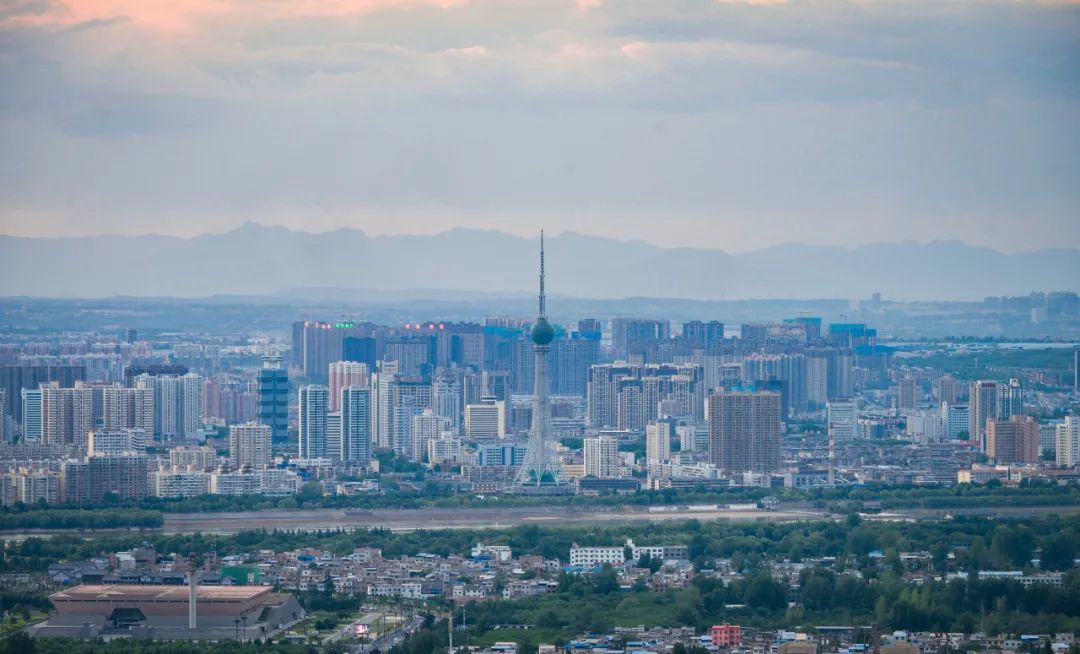
△ Geomorphology/Insect in Luoyang Basin
But only geography, still far from it. When the identity of the ancient capital of the 13th Dynasty was established, this bowl of soup in Luoyang was finally blended.
Starting from Xia and Shang Dynasties, the appearance of Ding began to soothe people’s stomachs in this land. Luoyang basin is also rich in wheat and other grains, and the rich products continue to feed this bowl of soup until the Wei, Jin, Southern and Northern Dynasties.
In A.D. 494, Emperor Xiaowen of the Northern Wei Dynasty moved the capital to Luoyang, with the original intention of "sinicizing" the people and realizing the great national integration. He did not think about this great integration, but also integrated "Hu Shi" into Luoyang’s diet. Influenced by the Hu people, the local people began to try beef and mutton while eating pork.

△ Suo beef soup
In addition, during the Eastern Han Dynasty and the Northern Wei Dynasty, Luoyang was once the capital, and the starting point of the "Oriental Silk Road on Land" was also moved northward to Luoyang. Merchants such as Dayue and Arabia did business in Luoyang, which naturally brought Hu Shi to Luoyang. They found that putting large pieces of beef into the soup, gulping soup and meat seemed to have more flavor.
It was not until the Sui and Tang Dynasties that this bowl of soup really tasted.
With the opening of the North-South Grand Canal and the blessing of the Silk Road, Luoyang, as the capital of Sui and Tang Dynasties, has become the largest commercial and handicraft center in the country, and the ship trade is endless. The prosperity of the economy and the arrival of Tang envoys from various countries have brought Luoyang’s soup culture directly to the peak.

△ Luoyang Tang culture
Thus, more than 1000 years ago, the representative work of diet in the prosperous Tang Dynasty-Luoyang water mat appeared. Of course, it represents the prosperous Tang Dynasty and Luoyang. The so-called "water mat", first, all hot dishes are soup and water; Second, serving food is like "flowing water", and after eating it, it will be followed by another.
Just thinking that this dish once appeared on the dining table of Wu Zetian in the prosperous Tang Dynasty, goose bumps rose. It is simply a typical representative player in China’s food culture. There are 24 dishes in the whole banquet, including eight cold cuts and four vegetarian dishes, and then 16 hot dishes. The first four dishes are used to calm down the table, and the last 12 dishes are in groups of three, respectively. To finish these, it is estimated that you can’t get off the table for two or three hours.

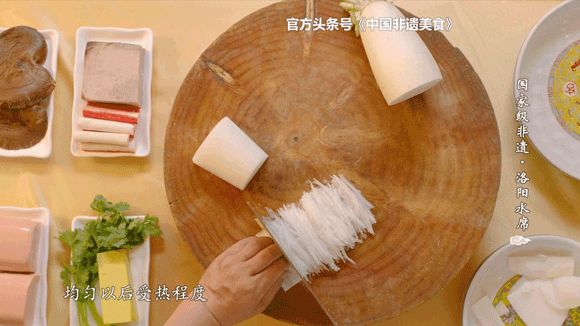
△ "Peony Swallow" of Luoyang Water Seats
The first dish of Luoyang water mat is "Peony Swallow", which is plain at first glance. Isn’t it just that shredded white radish, shredded ham and shredded crab meat are placed neatly, and then poured with clear soup? No, someone in bilibili has explored how thin the shredded radish in "Peony Swallow Vegetable" is, and found that it can pass through the needle, and the shredded radish is uniform, and it really can’t be done without decades of skill.
In addition, this water mat is made of whole chicken, sliced pork in soup, fried meatballs, etc. The tastes are salty and sweet, rich and weak. It can be said that "the Qing people come first, the rich ones come later, the righteous ones dominate it, the strange ones are mixed, and the tongue is tired, and the Xin is shocked, and the stomach is full, and the acid is overflowing." All guests are suitable and enjoy themselves.

△ fried meatballs
When the water mat in Luoyang has passed through more than 1,300 years, it can still land firmly in today’s Luoyang, and it is also called "the three wonders of Luoyang" with the Peony Flower Festival and Longmen Grottoes. You will know that the Tang culture has its own rivers and lakes in Luoyang.

Luoyang people’s favorite is not hot soup.
When we came to Henan, we were easily solidified by the dietary thinking of "Hu Spicy Soup, Huimian Noodles", thinking that we had to order a bowl of Hu Spicy Soup when we arrived in Luoyang, but the most authentic way to eat in Luoyang is no longer a bowl of Hu Spicy Soup.
Hu spicy soup first spread from Xihua County, Zhoukou City, so compared with eastern Henan, Luoyang people in western Henan don’t seem so good at it. More importantly, Luoyang people can choose too many soups.
In addition to the water mat, the smell of soup has long fascinated Luoyang folk.
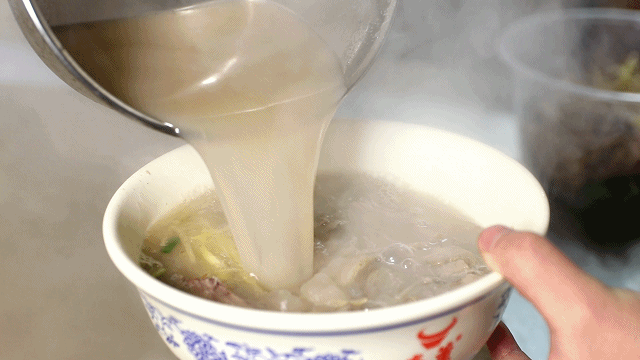
△ Luoyang people can choose too many soups.
A bowl of steaming beef soup is the choice of most old Luoyang people to open the morning. Less than seven or eight o’clock, Luoyang people gathered in front of the open-air stalls and rushed to drink a bowl of soup. The moist hot air seemed to meet the taste buds of the ancients thousands of years ago, just as the ancient history test said: "Lv Wang tasted the slaughter of cattle and sang songs in the morning, selling drinks in Mengjin."
It is not easy to cook a bowl of beef soup. You have to soak the beef bones for a day and a night to remove the blood, and you have to keep changing the water until the bottom is clear before you can go to the pot. Then simmer for seven or eight hours until the soup base becomes white and fragrant.

△ mellow and fragrant beef bone soup, who doesn’t want to come to a bowl?
Old soup drinkers who drink fine will choose "sweet soup", which does not mean sweet taste, but no salt. A good pot of beef soup has such confidence, without adding salt, seasoning or pepper. The tongue first touches the freshness and mellow of the soup, and the aftertaste is fluid. The warm and silky soup drops down the throat, and the taste buds and perception reach a critical point in an instant, which is absolutely home.
Heavy-mouthed diners can also choose "salty soup", with beef ranging from six to fifteen pieces. Choose green onion and coriander, then pour a large portion of soup, soak the steamed buns in the soup, add salt by themselves, and then spread a layer of fire-like red chili pepper. The aroma immediately catches people’s hearts and makes them eat it dry and neat.

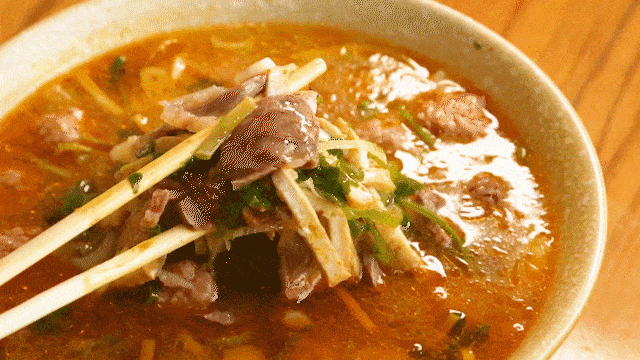
△ "Sweet Soup" and "Salty Soup" of Luoyang Beef Soup (Ⅰ) (Ⅱ)
Tired of eating beef soup, as well as mutton soup, donkey broth and miscellaneous liver soup, they can always find tricks in the hands of the master.
A good bowl of mutton soup pays attention to "delicious taste, fat meat and clear soup". Put the cracked sheep bones into the pot and simmer slowly all night until the bone marrow and collagen are melted into the soup. The soup base can be fresh and bright, and the mutton is fragrant but not greasy, fat but not fishy. Eating a piece of mutton and drinking a mouthful of soup makes the meat more "beautiful" in the mouth cavity, and it is sealed in the mouth together with the aroma, which will never run away.
In Luoyang, there are many gourmets who drive to Tiexie in Mengjin to taste the old mutton soup that has been precipitated for a hundred years.

△ Mengjin Tiexie mutton soup
If you don’t want the smell of meat to fill your mouth, you can come to a bowl of vegetarian soup to remove fishy smell, greasy smell and oil. Tofu soup, meatball soup, non-turning soup and Hu spicy soup are all waiting for diners to turn over the cards.
Although bean curd soup is vegetarian soup, it is full of ingredients: white bean curd is the main material, ginger is the auxiliary material, hot vermicelli, oily bean curd and vegetables are added, chopped green onion, coriander and Chili oil are sprinkled, and the soup is poured up, which is delicious.
Although the bean curd soup is simple, the oil alone needs to be fried with more than a dozen spices, such as fragrant leaves, fennel, star anise, clove and cinnamon. The tender bean curd like sheep fat is square and unbreakable. Just take a bite, and the bean fragrance will be integrated with the soup.

△ Luoyang tofu soup/worm
Finally, there is a soup that is worth tasting. This strange name actually refers to the mung bean flour cake on the noodle soup, which can be cooked without turning it over, hence the name "no turning".
Put this glittering and translucent green "corner" (without turning) into a bowl, then add vermicelli, fungus, shrimp skin, kelp silk, seaweed, etc., and then add some vinegar and pepper to enhance the freshness and remove the fishy smell, and a bowl of boiling soup will be ready. Putting "don’t turn" into your mouth is soft, sour, refreshing and appetizing, which makes people want to have another bowl.
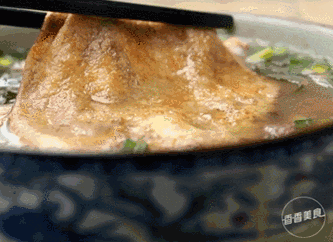
△ no soup
The soup in Luoyang is really touching.

To drink soup in Luoyang, you have to know some doorways.
The smell of soup in Luoyang has already reached the homes of ordinary people along the ancient walls of the Millennium. After a bowl of beef soup, and then two oil whirls, it is no wonder that the locals say, "A bowl of soup in the morning is not appropriate for a fairy." After more than a thousand years of precipitation, soup has long been drunk by Luoyang people as a culture.
If you go to Luoyang in a hurry, outsiders really can’t easily drink a tunnel. When drinking soup in Luoyang, you have to talk about some doorways and summarize them simply. That is two words-men.
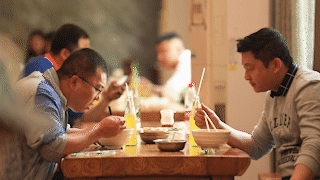
△ Follow the old Luoyang people to drink soup, and you have to know some doorways.
Old Luoyang never uses a spoon to drink soup. For them, it is boring to scoop soup into their mouths in small sips. If you want to use chopsticks, put a big pinch of meat in your mouth, then look up and drink half a bowl of soup, and the steaming heat will instantly wrap your bones, which is comfortable.
They also pay attention to the first pot of soup. If you want to drink a bowl of good soup in Luoyang, you can’t sleep in yet. Go downstairs at ten o’clock. Sorry, the good soup is sold out. In the eyes of the old Luoyang people, there is an old saying: "Drink soup at seven o’clock (original flavor), drink oil at eight o’clock (taste by oil), and drink water at nine o’clock (clear soup with little water)."
If some old shops have good business, there will be a long queue before five o’clock for the first three bowls of soup. If you want to taste a tunnel, you must be right to follow them.

△ The soup at five o’clock in the morning is the most soothing.
Luoyang people drink soup, and they are used to matching some pasta. Otherwise, how can you say: "A bowl of hot soup mixed with dry goods, accompanied by staple foods such as shredded cakes and oil whirlers, is a proper meal."
"Lean meat, pancakes and original soup" were named as "three beauties" by the old Luoyang people, and they are all indispensable. There are many pancakes used to accompany soup, such as oil whirl, sesame seed cake, pot helmet and shredded cake. You can choose at will, and you will never have to worry that this bowl of soup will make you feel lonely.

△ oil whirl
Oil whirl is the most familiar old friend of many northerners. When the bread is rolled into a "whirl" and baked at high temperature, the freshly baked oil whirl is crispy in the skin and soft and tender in the inside, coupled with a bowl of beef soup, which tastes like no one.
Sesame cakes and oil whirls can be eaten with soup, while pot helmets and shredded cakes are generally soaked directly in soup. The pot helmets are torn into small pieces and soaked in soup, and when the soup is fully absorbed, it will be soft and tasty.

△ soup with shredded cake
However, that’s not enough. You have to know some jargon before entering Luoyang Soup Restaurant. From the moment you push through the door, you have to face the whole Jianghu. The boss will judge whether you are an expert or not according to your words and deeds.
"Do you want meat mixed?" "Clear soup or fat soup?" "Double pepper."
Only by understanding these words can you get the entrance ticket to Luoyang to drink soup. "Do you want meat mixed?" I asked if your soup should be beef and mutton or beef and mutton. "Clear soup or fat soup?" Refers to whether this bowl of soup needs oil; And "double pepper" refers to putting double oil-splashed peppers in the soup bowl.
If you shout out "clear soup, double pepper" in the store, the owner of the store can’t help but sit up and take notice of you.
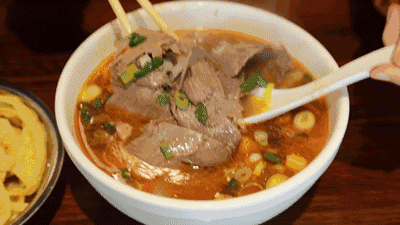
△ Test you, what is this?
In Luoyang, there is another established rule: adding materials requires money, and adding soup does not require money. As a result, this has become the staple food of dock workers and restaurant waiters in Luoyang in the past. In the face of steaming soup, people are not divided into three or six, and they are not full. Just shout: "Boss, full." That spoonful of clear soup will fill the bowl along the spoon.
The taste and seasoning are also arranged by yourself. Salt, pepper, vinegar and pepper are rich and thrifty by people. From the taste of soup, we can see a person’s rank. The older Luoyang people who know how to drink often require the lighter taste, which is somewhat similar to that of Cantonese people.
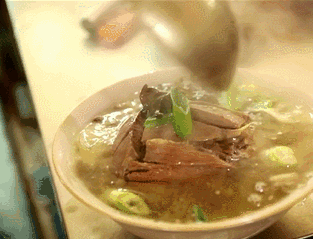
△ When the soup is gone, you can also call the boss full.
In the soup world, Luoyang is really wronged. Obviously, it is a king, but it is misunderstood that "only Hu spicy soup". To show the strength of the ancient capital of the 13th Dynasty, soup is a good outlet.
Although Luoyang is a little lonely now, that soup will always linger at the bottom of the tongue, and it will always be the biggest concern of Luoyang people outside Longmen Grottoes, Baima Temple and Peony Flower Festival.
References:
1. On the Formation Factors of Regional Food Culture —— Taking Luoyang Tang Culture as an Example.
2. The Relationship between Luoyang "Tang" Culture and Its Regional Environment —— Taking "Water Mat" as an Example, Tian Tian
3. "Soup as Tasty as Luoyang" Sun Beichen
4. Luoyang people love soup, and their favorite is not The Paper, a hot soup.
5. How delicious is a bowl of authentic Luoyang soup? Alva
This article is the original content of the signing account [Nine Lines] of Netease News Netease New Humanity Wave Plan, and it is forbidden to reprint it at will without the authorization of the account.

Do you want to go to Luoyang for soup?

Huang Jiabao
Editor | Second Uncle
Typesetting | Gloria
The pictures in this article are from the Internet.
Original title: "A bowl of hot soup, you can’t get rid of Luoyang people at all"
Read the original text



























































































